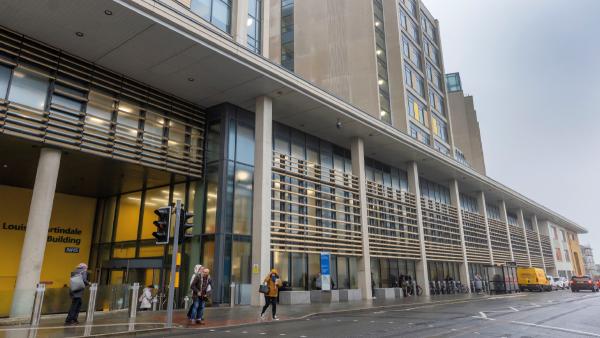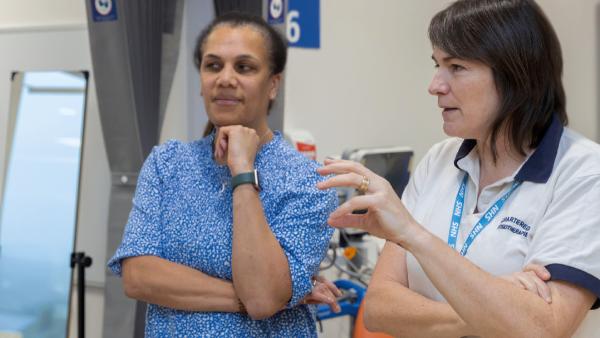Against a national backdrop of losing rehab space a positive story is being celebrated in Brighton. Gary Henson reports
Views’ is a word often heard by staff, patients, and visitors at the Louisa Martindale Building above the Brighton sea front. They hit you in every direction in the new facilities, which overlook the ocean.
Access to rehab space in the new facility is in stark contrast to those of the previous building, the oldest working NHS building in Britain.
There are now three rehab gyms with the latest equipment for rehabilitation covering inpatient neuro, critical care, stroke and hyper acute stroke, major trauma, respiratory, frailty and orthopaedics. Also used by the multidisciplinary team, they feature a patient OT bathroom, kitchen, and bedroom.
The largest gym on level 10 has enough space for 30 patients, although current staff levels allow 12. The stroke team has been able to do far more exercise groups and all sorts of interventions with the patients as a result. An outside terrace facilitates rehabilitation.
MSK physio Natalie Opoku, who is also a CSP regional steward, oversaw the physio team move to the new rehab facility while being a member of the project team managing all the moves.
‘The Barry building desperately needed to be replaced. We’ve gone from having the oldest to the newest building in the country.’
Highlighting the importance of therapies involvement in hospital re-design, Natalie said it ‘really helped’ to have therapies representation as part of the project.
Rehab space was part of the remit for the whole hospital works. ‘Because the hospital is about the wellbeing and outcomes for patients, 14 years ago when planning started what we had at the time wasn’t adequate for rehab patients so we needed to ensure there was the right amount of space for them.
‘We had no rehab space in the old building. We had this little, what was a side ward, tiny area, where it meant we could squeeze two plinths in and try and do rehab but that was for everyone.’
Staff were able to participate in the design of the space using virtual reality technology to provide feedback and suggest improvements.
Benefits of the new building
The new build, which is part of a £485m capital redevelopment of the old hospital facilities, sees inpatient facilities moving from some buildings which pre-date Queen Victoria into a modern spacious space which gives staff dedicated admin spaces, rest rooms, meeting rooms and full changing facilities.

Until its closure in June 2023, when services moved into the new Louisa Martindale Building (LMB), the Barry Building was the oldest operational NHS building in the country, constructed in 1828.
The new building includes more than 300 beds, 28 wards and departments featuring the latest healthcare designs, so every patient room benefits from natural light with a sea view.
Patient wards are spacious and have separate areas for dining and family/friends. Each patient has five times more space than in the previous building. The LMB was purpose-built to make the most of the natural light and the sea views. It is themed according to the local landscape ‘sea, city, country’, with visual cues throughout with colour palettes and wall mural artwork that represents each of the themes to help with patient way-finding in the building and to improve wellbeing while in the hospital.
The new building brings the stroke unit and the acquired brain injury service together on one floor, in line with best clinical practice, with five times as much space per bed and with 65 per cent of beds in en-suite single rooms. Both the stroke and acquired brain injury services have access to a large, well-equipped rehabilitation gym, with an adjoining, dedicated courtyard garden that also supports patient rehabilitation.
Transformation for patients and staff
Life for patients and physiotherapy staff has gone through an ‘amazing and extraordinary transformation’ since the opening of the new building, says Cate Leighton, divisional director of allied health professionals at University Hospitals Sussex NHS Trust.
‘We now have access to several specifically designed rehab spaces which allows us to deliver the high-quality inpatient rehab that all patients deserve, and which contributes to their recovery.’
The addition of outdoor space for rehabilitation, with views across the English Channel, brings a new dimension to care and the possibilities on offer to patients, she said.
‘These are facilities our staff can now be proud of.’
It also brings together inpatient physios alongside speech and language therapists, dietitians and occupational therapists into purpose built clinical and admin spaces to support multidisciplinary working where the benefits for patients and teams alike are being seen, Cate explained.
‘Communication is enhanced, care is more appropriate to the 21st century and our teams no longer must deliver care in cramped and shabby spaces.
‘In the current recruitment situation, we cannot afford to rest on our laurels, and we are rightly proud of the look, feel and functionality of our staff and patient facilities. We’re seeing the benefits for patients and recruitment alike.’
The next stage for physiotherapy across the trust, and especially in Brighton, is describing career pathways with the educational and training opportunities on offer.
‘Bright open spaces for bright open staff who can join as an apprentices and see how they can plan their career to be the next consultant physiotherapist, the next professional physio lead or the next director of AHPs across an NHS trust which runs seven hospitals across Brighton and West Sussex and strategically leads thousands of staff across eight divisions.’
Cate explains this is all linked to the upcoming new AHP strategy that will describe the education, wellbeing and workforce opportunities and how physiotherapy will be part of that growth.
‘The vastness of the trust means the opportunities for physiotherapy are ever-growing large intensive care spaces, the opportunity to work in neurosurgery and a major trauma centre. Our colleagues can treat patients better and see the benefits for patient experience and outcomes. From here we encourage every team member to build the physiotherapy workforce with a sense of team, purpose and pride.’
An improvement in staff wellbeing
Royal Sussex County Hospital physiotherapy manager George Browne said: ‘The views are amazing, people feel better, we’re just at the beginning of the journey of what we can do with it. Improve work-life balance and quality for the patients. It’s a huge draw for people to come and work here as well.’
She describes changes in staff wellbeing since the move to the new building: ‘Simple things such as having proper changing rooms with accessible toilets and nice showers makes staff feel valued and it sets the tone for the rest of the working day.
‘Anecdotally staff are feeding back in their appraisals that the improved facilities and space for staff and improved clinical areas makes for a better working environment overall for all service-users.
‘Staff feel proud to bring patients, visitors and students into their work areas.
‘Compare this to before where cramped conditions meant the space for any kind of therapy or any form of intervention with patients was extremely challenging.
‘Now we have all this space it so much better. From a therapy perspective it is a dream.
‘Our neuro surgery team use this space so we have major trauma patients coming up here – that can make a huge difference as well – just getting away as it slightly de-hospitalises it because it has a ‘gym’ feeling.
‘Patients actually want to come to the gym!’
Wider team
While it is too early to give actual data on workforce retention, George highlighted: ‘The teams and individuals are finding it easier to work collaboratively both clinically and non-clinically due to an efficient, clean working space. ‘The visibility and ease of people being in an open office space facilitates more natural conversations and collaborative working. Teams have been enabled to do exercise classes, one-to-one rehab and therapy staff training in the multiple gym spaces and rehab roof terrace which should lead to better patient outcomes and staff satisfaction.’
The managers and team leads are more visible and accessible with dedicated office space within the therapy area, which is better for both as it reduces duplication, improves escalation of operational and service issues, and provides a more cohesive foundation for an effective therapy service.
‘Having a dedicated space for interviews, one-to-ones, appraisals, quiet conversations for example, means staff feel more valued as these things are carried out in a more professional and confidential manner so they feel more valued and respected, as opposed to having to find a space in the cupboard on a ward or in the corridor.’
Patient experience
Feedback from patients and families is being collated.
‘Anecdotal feedback from family, friends and visitors has been positive as it is a calmer and more considered space for recovery and rehab,’ said George.
Data collation on length of bed stay, patient flow and discharge home and to community services is also being gathered along with ICU recovery rates and in-patient falls.
CSP comment
CSP regional campaigns and engagement officer Mindy Dalloway said: ‘Nationally we have supported members campaigning to protect rehabilitation space with our #RightToRehab campaign to change appalling situations where patient gyms have been re-purposed, used as office space or closed altogether. In contrast to these negative stories, what we see in Brighton is investment in high-quality rehabilitation space which is transforming patient experience and outcomes and staff wellbeing.
Meeting the team, hearing their positive experiences and how they continue to work hard to make the most of the opportunities the new building has presented is inspirational to hear and gives hope for the future of rehabilitation provision.
Good rehabilitation is vital for better patient outcomes when discharged from hospital and the team at Brighton are well-placed to deliver this as a result.
We encourage our members to continue to protect patient access to rehabilitation with our support and resources covering top tips on things like data collation and how to influence decision-makers.
Protecting rehabilitation space is part of our wider campaign which emphasises the importance of rehabilitation throughout the patient pathway from hospital to home, which is vital to improve quality of life.’
If you would like support from your CSP regional team to promote or protect your rehabilitation service then email the team.
Find Out More
Number of subscribers: 1

![Photo of Physiotherapist Mahli Macwana [Photos: Brighton Pictures] standing between parallel bars](/sites/default/files/styles/unstyled_max_width_1200px/public/media-image/2024-03/image004.jpg?itok=gjtMCaLg)

